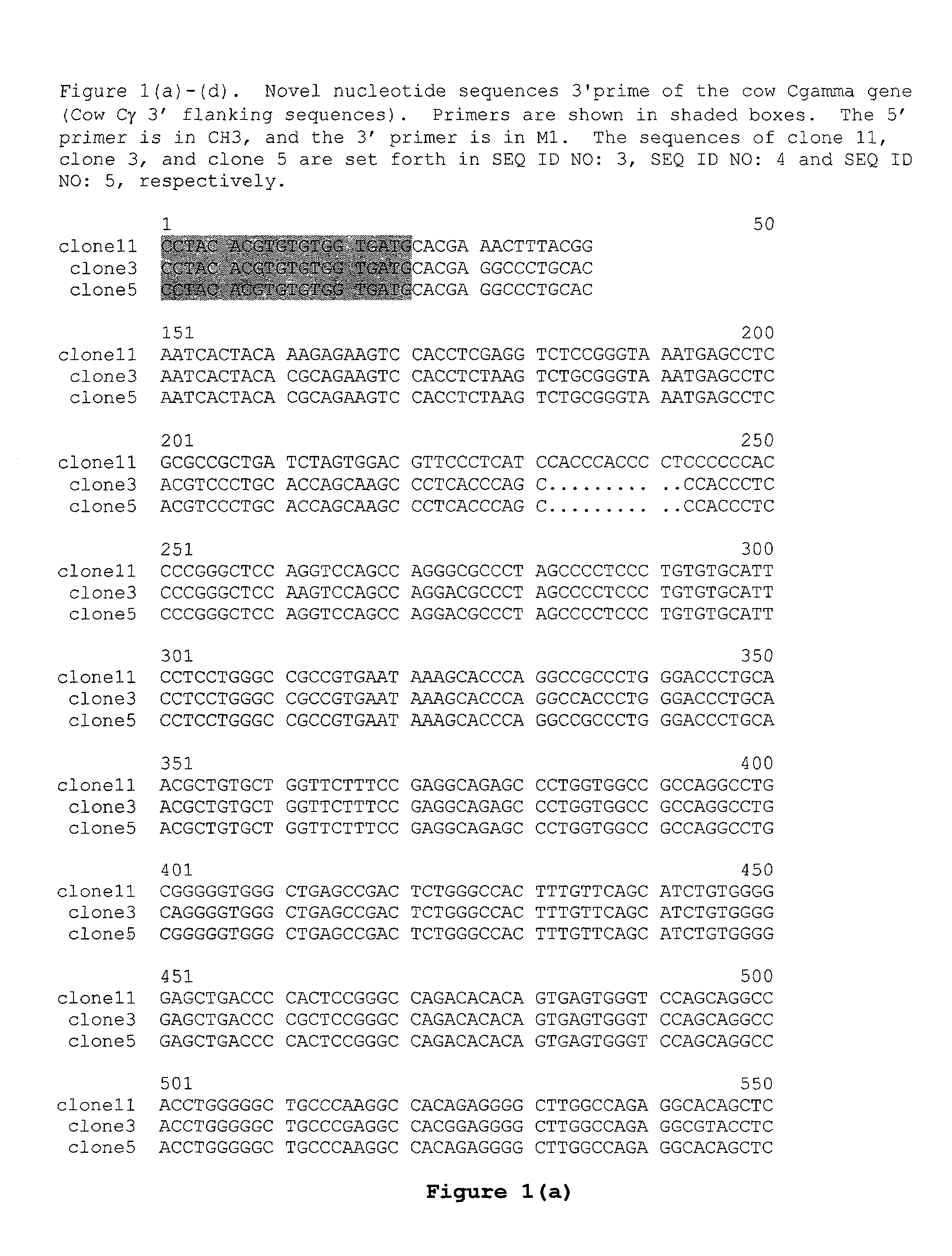Production of humanized antibodies in transgenic animals
a technology of transgenic animals and humanized antibodies, which is applied in the field of humanized antibodies, can solve the problems of high mortality of diseased patients, continuous development of new antibiotics, and intrinsic immunogenicity of non-human immunoglobulins in human patients
- Summary
- Abstract
- Description
- Claims
- Application Information
AI Technical Summary
Benefits of technology
Problems solved by technology
Method used
Image
Examples
example 1
Novel Sequences 3′Prime of the Cγ Gene from Cows, Sheep and Rabbits
[0127]Genomic DNA was isolated from blood of a Simmental cow using the QIAamp DNA Blood Kit (QIAGEN). The genomic region 3′ of the cow Cγ gene (i.e., the cow Cγ gene 3′ flanking sequence) was PCR-amplified using the isolated genomic DNA as template and the following primers:
[0128]
(SEQ ID NO: 1)5′ primer:5′cgcaagcttCCTACACGTGTGTGGTGATG3′;(SEQ ID NO: 2)3′ primer:5′cgcaagcttAAGATGGWGATGGTSGTCCA3′(Universal degenerate code: W = (A / T) S = (G / C)).
The upper-case portion of the 5′ primer was from exon 3 of Cγ, and the lower-case portion represented a terminal HindIII restriction site. The upper-case portion of the 3′ primer was a degenerate sequence designed according to the published sequences from the human M1 exon and the mouse M1 exon, and the lower-case portion represented a terminal HindIII restriction site. A 1.3 kb PCR fragment was obtained using the EXPAND long template PCR system (Roche). The fragment was gel purif...
example 2
A Vector for Replacing the Rabbit Endogenous Cγ Gene Segment with the Human Cγ1 Segment
[0134]Genomic DNA is isolated from rabbit fetal fibroblasts of an a2-homozygous rabbit. The DNA sequence upstream of rabbit Cγ (i.e., the 5′ flanking sequence of rabbit Cγ) is amplified by PCR using the following primers:
[0135]5′ taattatgcggccgcCTTCAGCGTGAACCACGCCCTC 3′ (SEQ ID NO: 39) with a 5′ NotI site and
[0136]5′ GTCGACGCCCCTCGATGCACTCCCAGAG 3′(SEQ ID NO: 40).
[0137]The DNA sequence downstream of rabbit Cγ (i.e., the 3′ flanking sequence of rabbit Cγ) is amplified with the following primers:
[0138]5′ ggtaccCTCTCCCTCCCCCACGCCGCAGC 3′ (SEQ ID NO: 41) with a 5′ NpnI site and
[0139]5′ atattcagaACTGGCTGTCCCTGCTGTAGTACACGG 3′ (SEQ ID NO: 42) with a 5′ NhoI site.
[0140]Human genomic DNA is isolated from human peripheral blood lymphocytes. The DNA fragment encoding human Cγ1 is amplified using the following primers:
[0141]
5′ GTCGACACTGGACGCTGAACCTCGCGG 3′(SEQ ID NO: 43)and5′ GGTACCGGGGGCTTGCCGGCCGTCGCAC 3′...
example 3
A Vector for Replacing the Rabbit Endogenous Cκ Gene Segment with the Human Cκ Segment
[0143]Genomic DNA was isolated from rabbit fetal fibroblasts of a b5-homozygous rabbit. The DNA sequence upstream of rabbit Cκ1 (i.e., the 5′ flanking sequence of rabbit Cκ1) was amplified by PCR using the following primers:
[0144]
(SEQ ID NO: 45)5′ gcggccgcTGGCGAGGAGACCAAGCTGGAGATCAAACG 3′with a 5′ NotI site(SEQ ID NO: 46)5′ GTCGACGCAGCCCAAAGCTGTTGCAATGGGGCAGCG 3′.
[0145]The DNA sequence downstream of rabbit Cκ1 (i.e., the 5′ flanking sequence of rabbit Cκ1) was amplified with the following primers:
[0146]5′ atatggtaccGCGAGACGCCTGCCAGGGCACCGCC 3′ (SEQ ID NO: 47) with a 5′ NpnI site
[0147]5′ GGATCCCGAGCTTTATGGGCAGGGTGGGGG 3′ (SEQ ID NO: 48).
[0148]Human genomic DNA was isolated from human peripheral blood lymphocytes. The DNA fragment encoding human Cκ was amplified using the following primers:
[0149]
(SEQ ID NO: 49)5′ ATATGTCGACCTGGGATAAGCATGCTGTTTTCTGTCTGTCCC 3′(SEQ ID NO: 50)5′ CTAGGTACCAGCAGGTGGGGGCACT...
PUM
| Property | Measurement | Unit |
|---|---|---|
| concentrations | aaaaa | aaaaa |
| concentrations | aaaaa | aaaaa |
| humidity | aaaaa | aaaaa |
Abstract
Description
Claims
Application Information
 Login to View More
Login to View More - R&D
- Intellectual Property
- Life Sciences
- Materials
- Tech Scout
- Unparalleled Data Quality
- Higher Quality Content
- 60% Fewer Hallucinations
Browse by: Latest US Patents, China's latest patents, Technical Efficacy Thesaurus, Application Domain, Technology Topic, Popular Technical Reports.
© 2025 PatSnap. All rights reserved.Legal|Privacy policy|Modern Slavery Act Transparency Statement|Sitemap|About US| Contact US: help@patsnap.com



